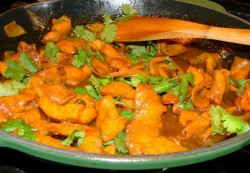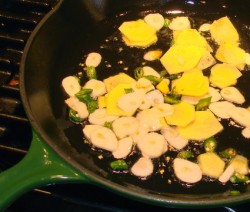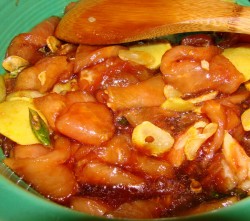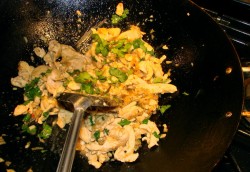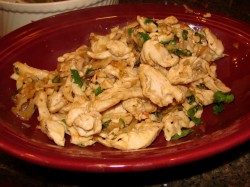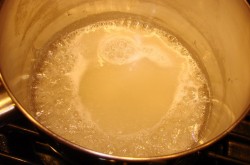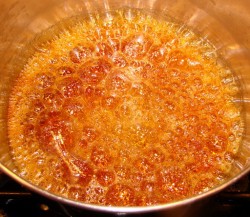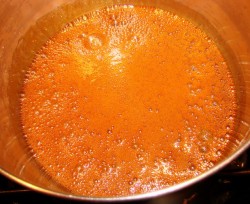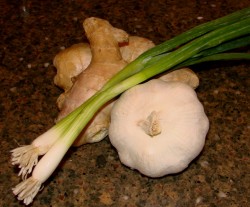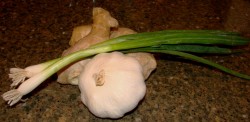Cooking the Soul Food of Vietnam: Kho
From what I have read and heard from Vietnamese friends, kho dishes are -the- comfort foods of their cuisine. This fairly broad category of dishes consist of braises, either long or short-simmered, which are primarily seasoned with nouc mau and fish sauce. These two sauces combine and cook down into a thick, gooey dark russet-brown glaze full of bittersweet, savory, salty satisfaction that coats the ingredients cooked into it and drips onto rice in rivulets of intense flavor. It is the sauce that defines a kho dish–it is meant to be intensely salty and sweet, in large part because it is meant to be eaten with a great deal of rice.
There are some who say that the origin of kho dishes comes from frugal cooks who used their culinary skills to create a dish which would stretch rare protein resources by saucing them with salty, sweet ingredients that would stimulate the diner to eat a great deal of rice. The result would be that one would need very little meat and sauce to flavor a meal of rice, thus creating a satisfying meal out of very few ingredients. (An illustration of this principle at work is seen in the beautiful Vietnamese film, “The Scent of Green Papaya,” which shows the older cook teaching the younger cook to use more fish sauce in a kho when the family they work for is short on cash. In making the dish saltier, the old cook knows that the young sons of the family will be forced to eat more rice, thus sating their hunger inexpensively.)
Whatever the origin, kho is a versatile method of cooking foods, which is well worth adopting to the American kitchen. While most often cooked in a Chinese style claypot, I found that using my Le Creuset pan worked just as well. (My claypot died a sad death a while back and has never been replaced.)
There are two ways to cook kho: fast and slow. They both require the same ingredients, and both methods end up with the same deeply flavored sauce, but the disparate cooking times are used depending upon what protein item one is cooking, how it is cut and how tender it is naturally. Tender meats such as chicken, pork loin, beef sirloin, shrimp and fish, are generally cut thinly and quickly cooked, as is tofu. Larger, less tender cuts, such as flank steak and pork belly, are generally cooked slowly for a long period of time.
Both the fast and slow cooking methods can utilize the addition of aromatic ingredients such as garlic, ginger, chilies, scallions or lemongrass; the way that these aromatics are prepared is the only difference. In both cases, the aromatics are also added to the marinade, which consists of the nuoc mau and fish sauce, in order to add their flavor to the sauce and the main ingredient during the marination period.
In the fast-braised recipes such as the one I present here, the aromatics are sliced very thinly and are stir fried in vegetable oil until they are lightly browned. Then they are added, along with the flavored oil to the marinating main ingredient. In long-simmered, slow cooked versions of kho, they are also sliced very thinly, but are simply cooked in the liquid along with the main ingredient without any prior cooking in oil.
The marinating period, which can last from thirty minutes to several hours to half a day or more, is a necessary step in the process of creating a kho. More tender, smaller cuts of meat or tofu can be marinated for a short period of time; it is easier for the flavors to penetrate thinly sliced tender meats than it is for them to insinuate themselves into larger, tougher cuts of meat.
For my recipe, which uses very thin slices of pork loin, I stir fried thinly sliced garlic, ginger and Thai bird chilies in a small amount of canola oil, and added that to the pork, nuoc mau and fish sauce, then let the whole thing sit at room temperature for about forty-five minutes.
Cooking the kho was a cinch: I simply dumped everything from the marinating bowl, back into the pan I used to stir fry the aromatics, added a few tablespoons of water, brought it to a boil, then turned down the heat to simmer it for ten minutes. The marinade turned into a rich, thick sauce that coated the meat generously, while the meat took on a satisfying, slightly chewy texture that was full of flavor. For more tender meat, I would have cooked it for only about seven minutes, but both Zak and I liked the contrast of the chewy, flavorful meat with the fluffy, aromatic steamed jasmine rice.
At that point, it is traditional to add a great deal of freshly ground pepper–however, since I am allergic to that, I skipped it. (That is why I added the chilies earlier, after all.) I simple stirred in a generous handful of roughly chopped cilantro, and served it forth with a dish of stir-fried vegetables.
How was it?
Beautiful, soulful and satisfying. I can easily imagine making this again and again, with various different ingredients. I cannot wait to make tofu this way; the sauce was sweet with caramel and garlic, hot with chile and ginger and savory-salty with fish sauce. Tofu cooked with black mushrooms in this way would be lip-smacking delectable.
And did we eat a lot of rice with our kho?
Indeed we did. And we loved every bite.
Quick-Braised Spicy Caramel Pork
Ingredients:
3/4 pound lean pork loin, most of the fat trimmed away and sliced into very thin 1″X1/2″ slices
7 tablespoons fish sauce
7 tablespoons nuoc mau
1 1/2 tablespoons canola oil
4 medium garlic cloves, peeled and thinly sliced
3-5 fresh Thai bird chilies, thinly sliced (to taste–optional–you can leave these out and just use a lot of freshly ground pepper at the end if you like)
2″ square chunk fresh ginger, peeled and thinly sliced
3 tablespoons water
handful of fresh cilantro leaves, roughly chopped
freshly ground pepper to taste (optional)
Method:
Put the pork in a bowl, then pour fish sauce and nuoc mau over it, and toss together with clean hands until they are well combined.
Heat the oil in a one quart claypot or heavy cast iron pot and add garlic, chilies and ginger. Stir fry on medium heat until the aromatics are nicely browned and smell very fragrant. Pour the entire contents of the pot over the pork and marinade, then stir well to get it to combine. Cover well and allow to sit at room temperature for forty-five minutes to an hour and a half. (If you marinate any longer, put in the refrigerator. And if you refrigerate it, when cooking the dish, you will have to double the amount of water to take into account the longer cooking time–unless you bring the meat to room temperature before cooking.)
Pour contents of bowl back into the pot, and add three tablespoons of water. Bring to a boil over high heat, then turn heat down to low and simmer for seven to ten minutes, depending on how thickly you sliced your pork (mine was thinner than 1/8th inch) and how tender or chewy you want your meat to be. For thinner meat, cook less, for tender meat, cook less. For thicker slices or more chewy meat, cook longer.
When meat is done and marinade has reduced to a thick, gooey sauce, remove from heat, scrape into serving bowl, and stir in cilantro. If using pepper, stir in at this time. Serve immediately with lots of steamed jasmine rice and a vegetable dish.
What To Do With Nuoc Mau: Stir-Fried Chicken with Lemongrass and Chilies
Now that I have about a cup or so of dark bittersweet delishousness in my fridge, I have to cook with it. While kuo dishes–braised dishes with gooey reddish brown salty-sweet sauce are one of the main uses of nuoc mau in the Vietnamese kitchen, the first recipe I tried was a stir-fry. Like I needed another reason to haul the wok onto the stove, but the combination of flavors promised in this recipe appealed to me: bittersweet caramel, caramelized shallots, browned garlic, fresh Thai bird chilies, lemongrass and fish sauce, all wrapped around tender bits of chicken.
How can that possibly be anything but good?
And, it is very easy to do, very quick to prepare and goes really wonderfully well over steamed jasmine rice, steamed sticky rice or steamed broken rice.
This chicken would be lovely tossed with bean thread noodles or pan-fried rice noodles, too, though one might want to add a bit more liquid to “dress” the noodles if one took that route with this recipe. Of course, if I do try that in the future, I will write about it. Reporting back is always half the fun of trying a new recipe.
I am even pretty sure it would be good as a filling for banh mi, which are those wonderful Vietnamese sandwiches on crusty French baguette that everyone always raves about. (With good reason, mind you–those suckers are tasty.) This summer when the world is bursting with vegetables, I will probably try out lemongrass chicken bahn mi for a quick and light supper, along with some cold noodle salad or maybe a soup.
Stir-Fried Chicken with Lemongrass and Chilies
Ingredients:
2 teaspoons cornstarch
1 tablespoon fish sauce
3/4 pound boneless, skinless chicken breast, sliced into thin 2″X1/2″ pieces
3 tablespoons peanut or canola oil
1 cup thinly sliced fresh shallots
3 cloves garlic, minced
3-10 (to taste) fresh Thai chilies, minced
2 stalks of lemongrass, root ends trimmed, bottom one third of stalks only, tough outer leaves removed, with the rest minced
1/2 cup chicken stock or broth
2 tablespoons fish sauce
1 teaspoon sugar
2 teaspoons nuoc mau
1/2 cup fresh cilantro, roughly chopped
Method:
Mix together cornstarch, first measure of fish sauce and chicken and allow to marinate for twenty minutes.
Heat wok over high heat until a thin thread of smoke wisps up from it. Add oil and heat until it shimmers-between thirty seconds to one minute, depending on how hot your stove is.
Add the shallots and stir and fry until they are golden colored–about two or three minutes. Add the chicken, and spread into a single layer over the bottom of the wok. Sprinkle the garlic, chilies, and lemongrass over the chicken. Allow chicken to sit undisturbed on the bottom of the wok for about a minute to brown slightly. (Chicken is ready when the edges turn white and you can smell the browning meat.) Turn meat and stir fry vigorously, until most of the pink is gone and the chicken is mostly white speckled with golden brown.
Add the chicken stock or broth, fish sauce, sugar and nuoc mau. Deglaze the browned bits on the wok with this mixture, then cook, stirring, until the chicken shows no pink and the sauce is thick and clinging to the meat.
Sprinkle with cilantro, take off heat and stir to combine.
The Essential Vietnamese Sauce: Nuoc Mau
It looks rather like sorghum molasses, or espresso with a swirled froth of reddish gold crema on top.
But it is neither of these things.
It is dark, it is deep, it consists of two ingredients, and while it is simple to make it is not easy.
And, it is an essential component to many Vietnamese home cooked foods.
It is called nuoc mau–which literally means “colored water,” though in English, we call it caramel sauce.
And it doesn’t go on ice cream.
It is what gives depth of flavor and color to kho, which are earthy, homey braises of meats, tofu or seafood. Salty with fish sauce, these dishes are meant to be eaten with plenty of rice, but the salt flavor is balanced by the smoke-tinged sweetness of this home made, darkly browned caramel sauce.
It is also used to flavor other dishes, including quick stir fries.
It is not difficult to make, as it only requires sugar and water, but technique is important. One must use medium-low heat, or risk burning the sugar black, and one must pay attention to when to stir and when not to stir. One can melt and brown the sugar without using water to dissolve it, but that method is much trickier and risks the formation of candy chips–incompletely melted sugar glommed together which will burn to the bottom of the pan if given half a chance.
I found that it helped that I had done pulled sugar work in my dessert classes in culinary school; some of the techniques I learned there to deal with melted sugar translated perfectly to the making of nuoc mau. It also helped to follow a detailed recipe that described very carefully and accurately the stages of browning the sugar was going to go through before the sauce was done. (I found that the best recipe is Andrea Q. Nguyen’s from her excellent cookbook, Into the Vietnamese Kitchen.)
At any rate, here is my way of putting this simple, but not easy staple of the Vietnamese kitchen together, complete with many photographs illustrating the stages the sugar goes through on its way from crystalline white grains to a reddish-brown, richly-scented sauce.
Nuoc Mau (Vietnamese Caramel Sauce)
Ingredients:
1 cup white sugar
3/4 cup water
Method:
Place the sugar and 1/4 cup of water into a deep, heavy-bottomed saucepan over medium low heat. Stir with a metal spoon until the sugar dissolves into a milky-looking liquid, as below.
As the sugar syrup heats up, small, glassy-looking bubbles will begin to form around the edges of the saucepan, as seen above. At this point, stop stirring, and DO NOT stir again. (And please, never, ever, use anything other than a metal spoon to stir melting sugar. Please never use a rubber spatula. Please. I watched someone in culinary school melt a rubber spatula into boiling sugar once. It was ugly and smelled really awful. Don’t do that–it is a hideous mess to clean up.)
If you stir again, you will cause the sugar to seize up and recrystallize, and that will not be a good thing. From here on out, if you need to stir the sugar syrup, do so by lifting the saucepan and swirling it in the air while keeping it level. This will cause some syrup to creep up the sides of the pan. In order to chase those droplets down before they have a chance to cool and recrystallize, take a pastry brush, dampen the bristles in the remaining half cup of water, and use it to brush the syrup back down into the pan.
As the bubbles form, they will head toward the center of the pan, where they will grow in size. Then, the entire surface of the sugar will be bubbling vigorously with glassy spheres and domes as it simmers merrily along.
After a few minutes, around the edges of the pan, you will see the syrup begin to darken slightly, going from clear to the color of champagne. Swirl the pan to even the color, and set it back on the stove. Eventually, the color around the edges will darken to a lager beer, then a honey color, as seen below.
Notice the color in the lower left-hand portion of the pot is more of a honey brown while the rest is more of a pale color. That tells us one of two things: either my pan has a place where it is thinner there, so it gets hotter faster, or that burner is pouring out more heat in that spot. At any rate, as the color darkens on the edge, lift the pan and carefully swirl once or twice to even the color out, then set it back on the fire. If you swirled a lot of syrup up the sides of the pan, brush them down.
Once the color of the syrup is the color of dark tea color, start watching it very carefully. This is where you come to the place where you may burn the sugar beyond use.
After the sugar has been simmering for about twenty minutes, a thin haze of smoke will steadily rise. Turn the exhaust fan over your stove on or open the windows. Watch the sugar closely as it will darken very quickly–second by second it will darken.
The sugar will take on a scarlet reddish tone–almost like wine, but with more of a yellow cast. The bubbles will take on a vivid burned orange color like the color of maple leaves in autumn or a seashore sunset–like the photograph above. At this point, swirl again and take note of the color of the syrup under the bubbles.
When it takes on the color of very dark coffee or molasses, turn off the heat and all at once add the other 1/2 cup of water. This will cause a dramatic bubbling, hissing, sputtering reaction as the sugar syrup rapidly cools. Just stay back from it and watch from afar.
Where the water pours directly into the syrup, the sugar will seize up, but don’t fret over it. It will melt again in a few seconds.
Heat the caramel back up, and stir once again with a metal spoon until the solid bits dissolve back into the syrup. At this point, turn the heat off again, and set the pan aside, allowing it to cool for about ten minutes. At this point, the bubbles will subside to an orange-red foam over the surface of the caramel that will slowly dwindle in size as the liquid cools down.
After ten minutes, pour the sauce into a heavy glass jar, seal it tightly and allow it to cool the rest of the way.
I store mine in the fridge, but you can just leave yours in a cool, dark cabinet if you like.
It will keep for a very long time–some say forever.
Bad News About Food
Well, all in the world of food is not sweetness and light.
In the past few days and weeks, some really ugly news has surfaced in the realm of food and health that I thought I would share with my readers. I do try to be positive here, but sometimes, I feel that we, as members of the reality-based community, need to look into the shadows and see what lurks there.
So, first up, we have this snippet of dread from The New Scientist: “Billions at Risk from Wheat Superblight.”
Basically, we are warned that there is a form of black stem rust fungus that threatens the wheat crop of the entire world. Originating in Uganda in 1999, it has already spread across Africa and has shown up in Yemen. It has the potential to spread to southern Europe, and father, wiping out the staple food of billions of people on our planet, ushering in the return of famines the likes of which we have not seen since the “Green Revolution” of the 1960’s. It was during that time that rust-resistant varieties were planted, thus avoiding widespread famine and death.
Who says we may see a return to the pre-Green days?
None other than Norman Borlaug, Nobel laureate, whose work in developing those rust-resistant wheat varieties led to him being awarded the Nobel Peace Prize in 1970.
I don’t know about y’all, but when someone like Norman talks about agricultural disaster on a global scale–I listen.
What is most unfortunate in this entire matter is that worldwide agricultural research budgets have apparently been slashed in the past few decades, leaving humanity unprepared to fight this dire threat to our food supply.
I have to tell you: I am more afraid of black stem rust fungus than I am of terrorists. All I can think of is the untold billions of tax dollars being pumped into funding a very dysfunctional Department of Homeland Security, while research in making our food supply safe and stable goes unfunded or under-funded.
That is just a shame.
Okay, if you are not sufficiently depressed by that news, how about this one from Reuters? “Eat a lot of beef? It may affect your son’s sperm.”
What? How could that be? I mean, people have been eating beef for thousands of years, and have been reproducing just fine all this time, right?
Well, yeah, but read on.
Researchers at the University of Rochester, have a theory that the reason that sons of mothers who remembered eating more than seven meals worth of beef per week while they were pregnant have sub-fertile sperm counts has something to do with pesticides, hormones or some other contaminants in the meat. These sorts of chemicals build up in the fat cells of animals (and of people, too, btw) and are then consumed by the mothers.
Some pesticides can either act in our bodies in a way that mimics hormones, while others can interfere with our own natural hormone production and secretion. And growth hormones and other hormones given to beef and dairy cattle have been theorized to affect humans who eat the meat of these animals as well.
What does line of research say to me?
That I have yet another reason to avoid factory farmed feedlot beef. As if I needed yet another one.
Finally, there is a small glimmer of hope on the horizon, in the form of three lawsuits aimed at ConAgra, the makers of the salmonella-tainted peanut butter that was in the news back in February.
It turns out that the cause of the contamination was a combination of dormant salmonella spores lingering in the manufacturing facility and a series of floods and water leaks in August 2006.
As a result of the recall, the FDA has announced that it is adding peanut butter to its list of high-risk foods and will institute more inspections of facilities that make it.
Meanwhile, there is a class action lawsuit that is being filed in Tennessee, and two separate suits are being filed in Palm Beach, Florida by women who became ill after eating the tainted peanut butter. Apparently, many other individuals across the country are filing suit against the food industry giant, in an attempt to force the corporation to have some accountability for the health and safety of those who buy and consume their products.
So, as I said, there is a little bit of silver lining to this dark cloud of food fears. It is possible that through legal action, food producers in the US might have to take a little more care in the making of their products.
Though, the way I see it, the peanut butter and salmonella sandwich scandal is just another reason to try and eat as few processed foods as possible.
Okay, that is all for now. Next time I write about food in the news, I promise to highlight more cheerful stories.
The Holy Trinity of the Chinese Kitchen
In the cuisines of South Louisiana, cooks speak in reverential tones of three essential aromatic ingredients which they call, “The Holy Trinity:”onion, celery and bell pepper.
Nearly every recipe starts with the Holy Trinity being sauteed in a heavy-bottomed pan, where their combined fragrance and flavor can then infuse the finished dish deliciously.
Chinese cookery, too, has a Holy Trinity of aromatics, though perhaps it is silly to call it that. South Louisiana is an overwhelming Catholic culture; perhaps in the case of China the allusion has little to no meaning. Instead, I suppose I could call the Chinese Holy Trinity a Triad.
“Triad” can refer to Chinese organized crime elements, but in this context, I see it in a more positive light. I see it as three elements of flavor working together to create a synergistic effect that is essential to successful Chinese cooking.
The members of this flavor triad are fresh ginger, garlic and scallions, and they are the cornerstones of excellent Chinese food.
It is a rare savory Chinese dish which does not contain at least two and very often three of these pillars of flavor in some form or another.
When stir frying, these three intrepid aromatics are usually the very first ingredients to hit the hot wok where they bathe in the sizzling oil, flavoring it intensely, so that the ingredients which follow their lead are kissed by the scent and savor of ginger, garlic and scallion. How these ingredients are cut determines how much flavor they add to a stir-fried dish; in general terms, the smaller the cut, the more intense the flavor, because tiny pieces expose more surface area to the extracting influence of the heated oil.
Aromatics ground to a paste have the most flavoring power, with minced or finely chopped bits coming in second. Finely julienned pieces are the next most powerful flavor enhancers, while thin, broad slices add subtle flavor and chunks or crushed whole cloves and pieces add delicate whispers of aroma.
Care must be taken when working with ground or minced ginger, garlic and scallion in a hot wok, however. The smaller cuts do indeed impart the most flavor potential, but their large surface area also accounts for a tendency to burn quickly and easily. Burnt aromatics do nothing for a stir-fried dish but render it unpalatable, and the difference between pleasantly browned and bitterly burned is naught but a matter of seconds in a properly heated wok.
In order to correct this problem, I often counsel cooks new to the art of stir-frying to either add the minced or ground aromatics -after- adding the main protein ingredient, whether that is tofu, seafood, poultry or meat, or that they add the minced aromatics and then immediately add the protein ingredient, without allowing the aromatics to infuse the oil on their own.
The reason for this is simple. If you take the former path and add the protein first, while it is browning undisturbed on the bottom of the wok, you can sprinkle the minced or ground aromatics on the top of the protein. Hot oil will still come bubbling up to hit the aromatics, and thus the scent and flavor will be somewhat infused, but not by gaining instant, intimate contact with the very hot metal of the wok. The protein ingredient shields the tiny pieces, and are flavored by these bits of aromatic ingredient sitting on top of them. Once the protein ingredients are browned, and stir frying commences, the likelihood of burning the aromatics is vastly reduced.
If the second path is taken, the immediate addition of the protein ingredients lowers the temperature of the wok a good deal, which means that the tiny bits of aromatics trapped under it in the hot wok are not as likely to burn. This is a trickier technique, however, because there is the possibility that the aromatics will burn anyway while the protein stays stationary on the bottom of the wok to brown, so I generally suggest to timid beginning wok cooks that they use the former technique. They both result in great flavor–the protein browns and gets crusty, the aromatics turn golden and the entire dish is infused with wok-hay.
When cooking with thin slices, or julienne or crushed whole bits, however, I always advocate putting the triad of ginger, garlic and scallion into the wok first, as I find that the flavor of a stir fry is immeasurably improved by this one simple action.
These ingredients, however, are not only used in stir-fried dishes, but also in braises, red-cooked dishes, steamed dishes, soups, dim sum dumplings, breads and noodle dishes of all sorts. They are truly universal flavorings in the Chinese kitchen and are utterly indispensable. The balance between these three flavors (or between two of these flavors) is often the primary element of any given Chinese dish, and as such, it behooves a cook to learn as much as possible as she can about them.
Ginger is a rhizome, and is considered to be warming. Its flavor is sharp and intense, yet light and floral at the same time. It is often used with fish, lamb, beef and other strongly scented flesh ingredients, because it is considered to be cleansing of strong odors. It is believed to strengthen a lax appetite, and is given to those suffering of a queasy stomach. It has the power to cut richness in a dish, bringing a note of springlike freshness to it. It is a primary ingredient in Chinese soup stocks and broths, where its presence is gentle and comforting. In some stir fries, it is crisp and used with a heavy hand in order to bring heat and fire to a dish of greens which are very much considered to have a damp, cooling quality.
Fresh ginger is so easily found in most American supermarkets these days, that I would never suggest that you purchase any ginger paste in jars; the flavor is quite simply unsatisfactory. I buy a great deal of the rhizomes at a time–a pound or so–because I use so much of it. If I can find really young ginger with thin, pinkish skin, I will buy even more of it than that, because I love the crisp, not-stringy texture and the sprightly, lemony flavor so much. I keep it in paper bags in my crisper drawer, but I am told that if one needs to keep it for a long time, one can bury the unpeeled rhizomes in a pot of sand and put them in a cool dark place like a closet. Or, one can peel the rhizome and put it in a jar, and cover it completely with a fortified wine or rice wine like Shao Hsing.
Garlic is ubiquitous, not only in Chinese cookery, but in most cuisines in the world. This relative of the lily consists of bulbs that are separated into several or many units, called cloves, around a central stalk. The stalk is the part of the plant that flowers and sets seed, but most farmers propagate garlic by carefully separating the cloves and planting them one by one. Each one will send up a flowering stalk and leaves, and will eventually grow a new bulb. Thus, from a single bulb of garlic, up to ten or twelve plants can be grown.
But enough about growing it–what about cooking with it?
Utterly indispensable, garlic can be by turns sweet and hot, soft or sharp, depending on the cooking method and how it is cut. Simmered long in red-cooked dishes, it becomes sweet and soft, with a seductive fragrance that beguiles the senses. Minced up and mixed into the filling for dumplings or wontons, then steamed or boiled, it enhances the natural flavor of meat, giving a pungent strength that is impossible to duplicate with any other ingredient. Sliced and stir fried golden brown, it gives incomparable flavor to myriad green vegetables, especially when paired with fermented black beans or ginger. Minced and used raw in dipping sauces, it is pungent and vibrant.
Garlic is well known for having antibacterial properties; in the days before antibiotics, it was used to dress battle wounds. I like drinking a broth with plenty of garlic and ginger in it when I have a cold, as the two act together to both drain stuffed up sinuses, and kill any bacteria that might be lurking in my throat waiting to cause a secondary infection. Besides, when I am so stuffed up that I can barely breathe, my sense of taste is diminished due to lack of the ability to smell clearly; ginger and garlic both are strongly flavored enough that whatever broth or soup I am drinking doesn’t taste like water.
I like garlic best paired with ginger, though there is nothing wrong with using it on its own, or with scallions. I am idiosyncratic in that I prefer to use more garlic with pork and more ginger with beef; to my taste, the sweetness of garlic brings out the natural sweetness inherent in pork, while the sharp fire of ginger brings fragrance to the strong flavor of beef. I love garlic with tofu and chicken as well, though, and while I can eat both without ginger, I cannot consider eating either without garlic.
Scallions are a type of immature onion that never grows into a proper bulb. They, instead, grow into long, slender shoots that look similar to small leeks, though the green leaves are hollow tubes instead of being flat like leeks. Also known as green onions and spring onions, scallions have a very subtle onion flavor that is not as strong as onions, but stronger than shallots. They are used extensively in Chinese cookery in combination with the other members of the “Aromatic Triad,” (Or, should I call them the “Aromatic Trio” after the Hong Kong film, “The Heroic Trio?”) to season stir fries, steamed dishes, dim sum, soups and braises.
Scallions are used in soup stocks the way that leeks are used in the French tradition of stock-making. They add a subtle onion flavor and aroma without being overpowering. Sauteed with sesame oil with slivers of ginger, julienned scallions are used to dress steamed whole fish Cantonese cuisine. The two flavors combine to bring out the inherent sweetness and delicacy of fish, and the colors of the pale green slivers mixed with the cream colored slivers of ginger look lovely against the iridescent shimmer of fish skin.
Thinly sliced scallions star in scallion pancakes, a street food of Beijing. They add sweetness and pungency to the crisp-chewy layered wheat flour pancakes that is hard to resist. (Scallion pancakes are my mother’s favorite Chinese food.) Often used raw in many dipping sauces and as a garnish for many stir-fries, dark green scallion tops bring a note of crunch and freshness to every dish they touch. In many dishes, the white and light green parts of scallions are used early in the cooking process where their strength is tamed by heat, and the tops are used at the end, in order to add color and a brisk snap of onion flavor.
This versatility of the scallion ensures that it is used in many classic combinations with its two compatriots, ginger and garlic, in the Chinese kitchens of yesterday, today and tomorrow, in China and all over the world.
Personally, if I were to have to use only three aromatics in my kitchen, I believe I would probably pick ginger, garlic and scallions. I am so used to starting many recipes with them, that I am not sure I would know what to do without them.
Luckily, they are easily obtained, and here in Ohio, both garlic and scallions are easily grown. Ginger, being a tropical rhizome, could be grown in pots or a solar-warmed greenhouse, but I am not sure I could grow enough to keep our household supplied in it. Luckily there are many farmers here in Athens, however, who grow plenty of scallions and garlic for us all.
Powered by WordPress. Graphics by Zak Kramer.
Design update by Daniel Trout.
Entries and comments feeds.

